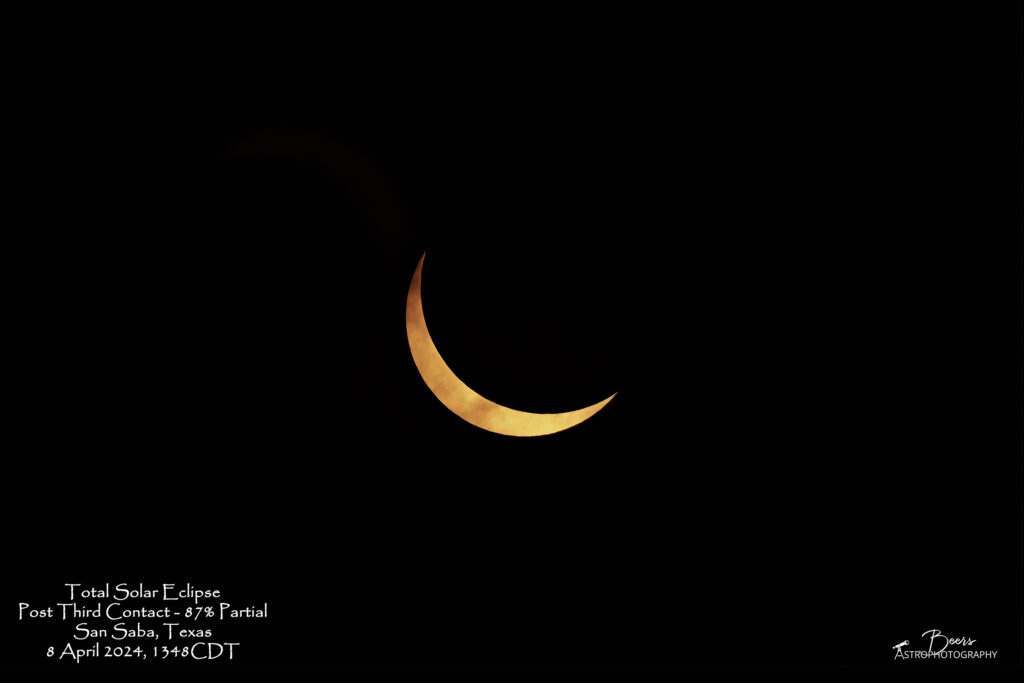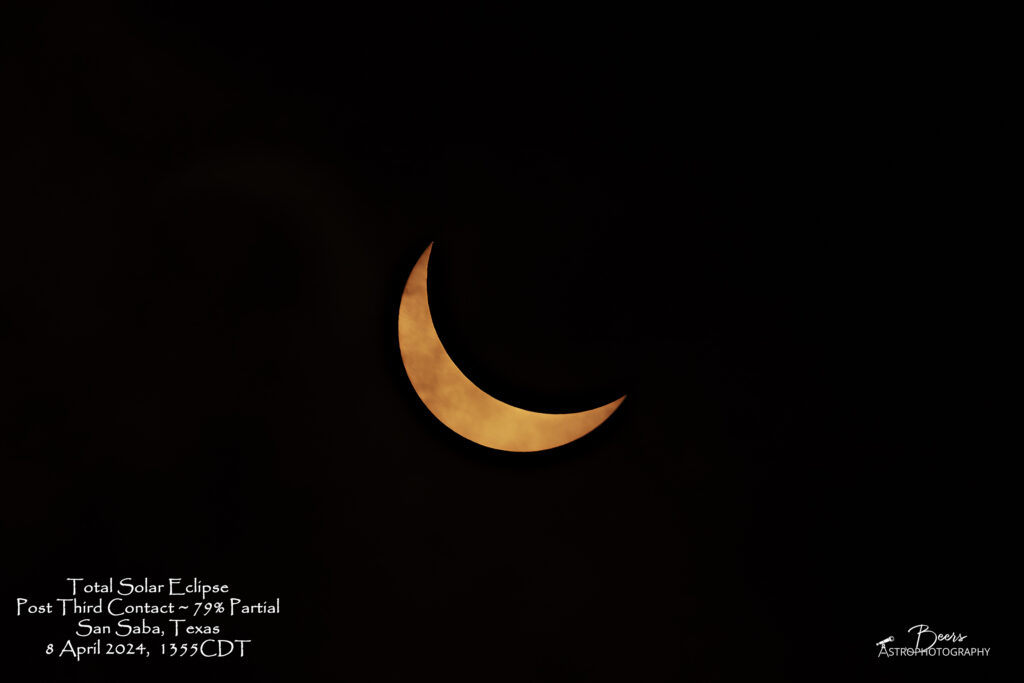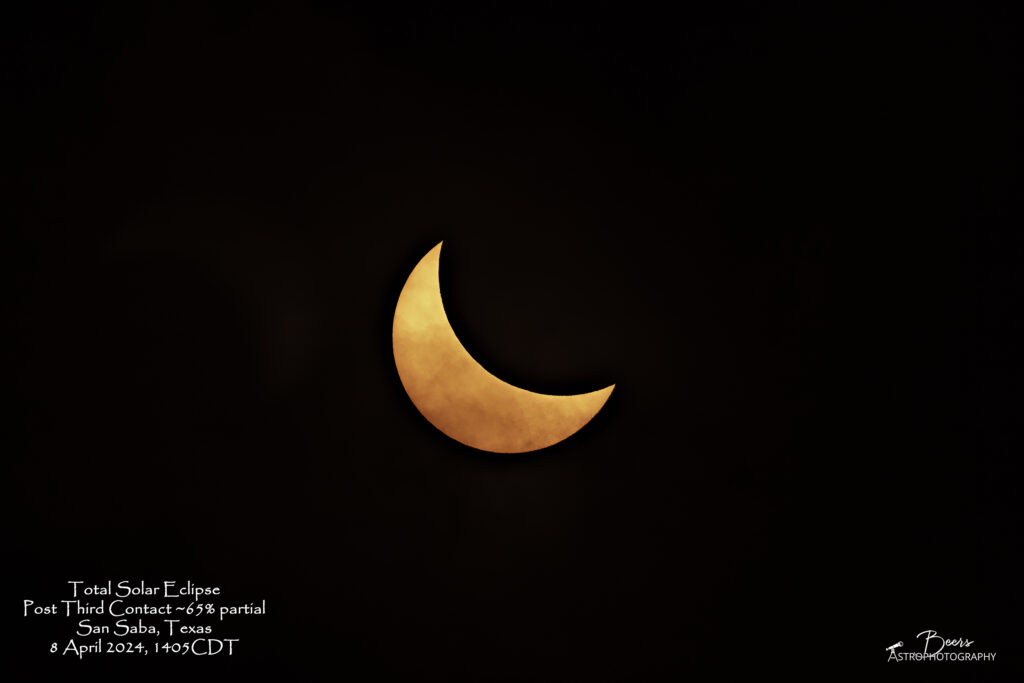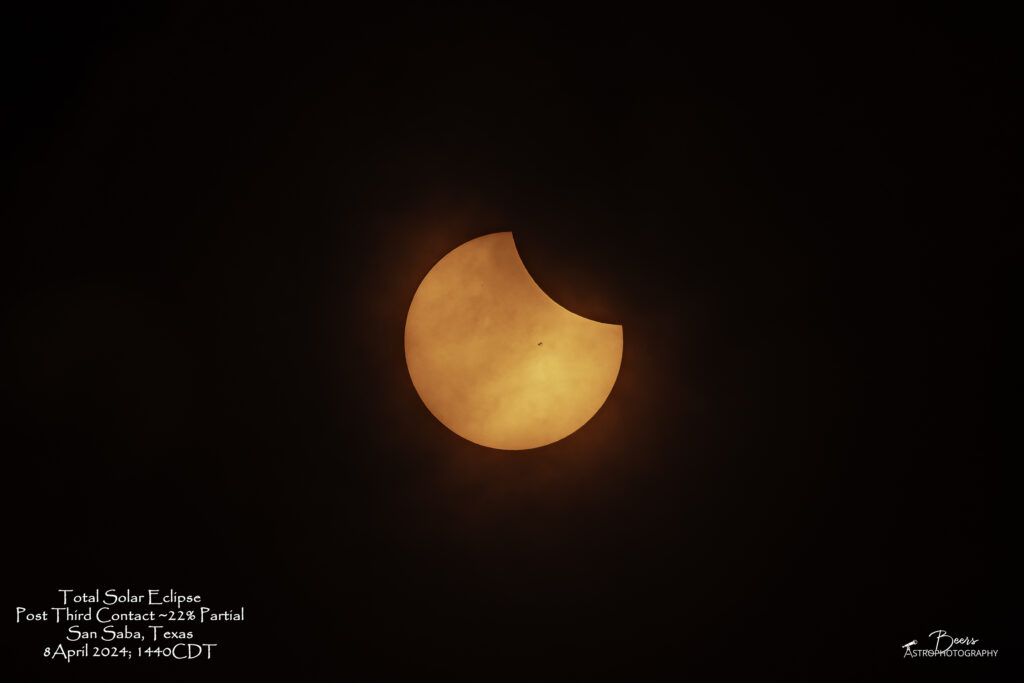
Total Solar Eclipse collage with the clouds that appeared just prior to totality as its backdrop; captured from San Saba, Texas on 8 April 2024
Eclipse Fun Facts

Image from: https://mynasadata.larc.nasa.gov/sites/default/files/2023-04/5661_Total_Solar_Eclipse_Shadows.jpeg
A total solar eclipse happens when the Moon completely blocks the Sun. This occurs when the Moon passes between the Sun and Earth while it is close enough to Earth that it appears to be the same visual size as the Sun. While, an annular solar eclipse happens when the Moon passes between the Sun and Earth while the Moon is at its farthest point from Earth. Because the Moon is farther away from Earth, it appears smaller and does not block the entire face of the Sun. As a result, the Moon appears like a dark disk on top of a larger, bright disk.
An annular solar eclipse has five stages:
- 1st contact: This is the beginning of the partial phase of the eclipse. The Moon’s silhouette begins to be visible in front of the Sun’s disk, as if a bite was taken from the Sun.
- 2nd contact: This is the beginning of annularity. The Moon is fully in front of the Sun and a “ring of fire” (sunlight) begins to form around it. As annularity begins, beads of light called Baily’s Beads may be seen along the edge of the Moon. These are caused by light rays from the Sun streaming through the valleys along the Moon’s horizon
- Maximum eclipse: The Moon covers the center of the Sun’s disk.
- 3rd contact: Annularity ends as the Moon starts to move away from the disk of the Sun. Baily’s Beads may be visible once again along the Moon’s edge.
- 4th contact: The partial eclipse ends. The Moon no longer overlaps the Sun’s disk. The eclipse is over.
Eclipses occur due to the special coincidence of the Moon and the Sun being the same angular size. The Sun is approximately 400 times wider than the Moon, but it is also approximately 400 times farther away, so they appear to be the same size in our sky. This is what allows the Moon to completely block the Sun during total solar eclipses. However, the Moon’s orbit around Earth is not a perfect circle, so when it is at its farthest point from the Earth the Moon will appear slightly smaller than the Sun. Eclipses that happen during this phase of the Moon’s orbit are known as annular eclipses, and the Sun is still visible in a “ring of fire” encircling the Moon. Eclipses do not occur every new moon because the Moon’s orbit is “tilted” relative to the Sun-Earth line. As a result, sometimes the Moon’s shadow is too high above Earth and sometimes it is too low. Other times, it is just right.
Below are descriptions of the phases of the total eclipse I was able to capture during the 8 April 2024 eclipse, pictured below.
Baily’s Beads & Diamond Ring: From: https://en.wikipedia.org/wiki/Baily%27s_beads }
The Baily’s beads, diamond ring or more rarely double diamond ring effects, are features of total and annular solar eclipses. Although caused by the same phenomenon, they are distinct events during these types of solar eclipses. As the Moon covers the Sun during a solar eclipse, the rugged topography of the lunar limb allows beads of sunlight to shine through in some places while not in others. They are named for Francis Baily, who explained the effects in 1836. The diamond ring effects are seen when only one or two beads are left, appearing as shining “diamonds” set in a bright ring around the lunar silhouette.
Lunar topography has considerable relief because of the presence of mountains, craters, valleys and other topographical features. The irregularities of the lunar limb profile (the “edge” of the Moon, as seen from a distance) are known accurately from observations of grazing occultations of stars. Astronomers thus have a fairly good idea which mountains and valleys will cause the beads to appear in advance of the eclipse. While Baily’s beads are seen briefly for a few seconds at the center of the eclipse path, their duration is maximized near the edges of the path of the umbra, lasting around 90 seconds.
Observers in the path of totality of a solar eclipse see first a gradual covering of the Sun by the lunar silhouette for just a small duration of time from around one minute to four minutes, followed by the diamond ring effect (visible without filters) as the last bit of photosphere disappears. As the burst of light from the ring fades, Baily’s beads appear as the last bits of the bright photosphere shine through valleys aligned at the edge of the Moon. As the Baily’s beads disappear behind the advancing lunar edge (the beads also reappear at the end of totality), a thin reddish edge called the chromosphere (the Greek chrōma meaning “color”) appears. Though the reddish hydrogen radiation is most visible to the unaided eye, the chromosphere also emits thousands of additional spectral lines.
Chromosphere & Solar Prominence: {From: https://en.wikipedia.org/wiki/Solar_prominence }
In solar physics, a prominence, sometimes referred to as a filament, is a large plasma and magnetic field structure extending outward from the Sun’s surface, often in a loop shape. Prominences are anchored to the Sun’s surface in the much brighter photosphere, and extend outwards into the solar corona. While the corona consists of extremely hot plasma, prominences contain much cooler plasma, similar in composition to that of the chromosphere.
Prominences form over timescales of about a day and may persist in the corona for several weeks or months, looping hundreds of thousands of kilometers into space. Some prominences may give rise to coronal mass ejections. Exact mechanism of prominence generation is an ongoing target of scientific research.
A typical prominence extends over many thousands of kilometers; the largest on record was estimated at over 800,000 km (500,000 mi) long, roughly of solar radius.
Stellar Corona: { From: https://en.wikipedia.org/wiki/Stellar_corona }
A corona (pl.: coronas or coronae) is the outermost layer of a star’s atmosphere. It is a hot but relatively dim region of plasma populated by intermittent coronal structures known as solar prominences or filaments.
The Sun’s corona lies above the chromosphere and extends millions of kilometres into outer space. Coronal light is typically obscured by the glare of the main solar disk, but can be easily seen by the naked eye during a total solar eclipse or with a specialized coronagraph. Spectroscopic measurements indicate strong ionization in the corona and a plasma temperature in excess of 1000000 kelvins, much hotter than the surface of the Sun, known as the photosphere.
Equipment
As with the 14 October 2023 eclipse, in an abundance of caution, we set up three separate imaging rigs, they were:
- Canon EOS Ra on Southern Cross (Askar FRA600 telescope on Rainbow Astro RC-135E mount) with Thousand Oaks Optical S-6000 Full Aperture (Solarlite Polymer) solar filter. Controlled by DSO-CTRL2 laptop running Solar Eclipse Timer and Camera Controller (SETnC).
- Canon 5DSR with Tamron 150-600mm lens (at 600mm) on Sky-Watcher Star Adventurer star tracker with Thousand Oaks Optical 95mm solar filter. Controlled by DSO-CTRL2 laptop running Solar Eclipse Timer and Camera Controller (SETnC).
- Canon 5DSR (PAB) with Canon 24-105mm lens (at 24mm) on tripod with Thousand Oaks Optical 77mm solar filter. Controlled with hand-controller to take a two-second exposure throughout totality in an attempt to capture the eclipse, parade of planets, and Pons-Brook comet.
Capture & processing notes
We traveled (in separate cars, with a mid-point stop in Amarillo, TX) with our good friends, Jan and Dave, to San Angelo, Texas – the closest town to the path of totality with a Hilton or Marriott hotel and one we were familiar with after spending Christmas 2020 there with Stephanie and Victoria. We ended up with a fringe benefit – Stephanie was there for another round of training at Goodfellow AFB and it was a week before she was to pin-on Captain. So, we held a pin-on ceremony in the hotel and experienced the eclipse!
We had originally planned to image the eclipse from the Llano Municipal Airport. On Sunday, 7 April 2024 we planned a recon mission to check out that site. Before leaving the hotel we talked to a few other eclipse viewers. Through those conversations, we found a couple of alternative locations. Our recon mission turned into a loop – San Angelo to Brady to Llano to San Saba. At our last stop, before heading back to San Angelo, we had lunch at San Saba and fell in love with the little town. It was very welcoming – the people and the quaintness of the town. We decided, that if in the morning the weather forecast was the same for all the locations, we would go to San Saba.
Although the forecast had been dismal (full clouds and thunderstorms at the time of totality) in the week leading up to the event, on Sunday it started to shift. By Monday morning (8Apr2024), it was 0-1% cloud cover throughout the eclipse for all three locations! So we packed up and headed to San Sabo. We found a great spot in the Mill Pond Park. Beginning at about 0900 we set up the same three rigs used during the partial eclipse in Los Alamos, with a couple of tweaks.
We got all three rigs set up, with very little time to spare before the beginning of the eclipse (C1 at 1216CDT). Then began the learning adventure with SETnC (yes, we had practiced beforehand, but that’s never completely the same as game time!) to actually get the imaging started. I had on my checklist to change the laptop time zone to CDT – but had forgotten. It turned out that (after going through that exercise of changing from MDT to CDT, and still having SETnC tell me that the eclipse was 5 hours from starting), it finally dawned on me that the computer clock needs to be set to UTC. Once we did that (my changing the laptop settings, while Dave held the umbrella over me to shade the screen from the bright sunshine), the program worked well (sort of)…
The SC continued to experience problems since the Southern Hemisphere trip – it manifested itself during the eclipse in dismal tracking performance (suffice it to say, I never sat down because I was continuously adjusting the mount to re-center the sun, and in spite of all that effort, none of the pre-totality shots were anywhere near centered in the frame). Finally, near the end of the eclipse, as Dave and I were talking to another photographer, Dave said “Suzanne, something’s going on with the telescope, it’s not pointing toward the sun anymore.” The other photographer said, “Yes, it’s sagging” I thought – “it doesn’t sag…” But it was sagging and the hand controller became unresponsive, as if the battery was drained (the same “performance” I had in January with the RST-300 when it ran out of DC power). The voltage read 12V, but the mount had no intention of responding to the hand controller and parking, even when I took the telescope off (yes, and laid it in the grass) to see if it would respond without any weight on it…
The other issue with SETnC…when I changed out the battery on the Canon EOS Ra just prior to totality (to make sure it didn’t run out of juice in the middle of totality) – it reverted back to its “factory settings” (that you have to put in on multiple screens before it finally takes): Auto ISO and .jpg image capture. Although I got some interesting cloud images that were not captured by the Canon EOS 5DSR, that was obediently staying at ISO 200 and it’s assigned exposure times, the .jpg images proved suboptimal during processing.
So, most of the images you see below came from Rig#2 (Canon 5DSR camera with Tamron 600mm lens on Skywatcher Star Tracker). I did not have to change out the Canon 5DSR battery (it was still showing full prior to totality – so if it ain’t broke, don’t fix it!), so the camera continued to follow it’s SETnC assigned exposure table. I executed the meridian flip prior to totality and the star tracker did an amazing job of tracking! Thank goodness!! Rig #1 (Canon EOS Ra on the Southern Cross), because of SETnC’s re-set auto ISO and exposure, ended up giving me some interesting cloud and eclipse images, but not much else. Rig #3, set up with the 24mm lens to capture the eclipse, parade of planets, and Pons-Brook comet, ended up with some interesting “big picture” cloud images. But only the eclipse and Venus were visible, with none of the rest of the planet parade or the comet in sight.
Sequence Plan and Capture:
Capture: 8 April 2024, 1223-1447CDT
Shooting location: Mill Pond Park, San Saba, Texas
Rig 1 (Canon 5DSR on Southern Cross with Solarlite Polymer filter): 661 images, captured 8 April 2024, 1223CDT – 1447CDT. SETnC exposure table was set for ISO200, f/8. During partial phases, every 2 minutes exposures at 1/1000, 1/500, 1/250, 1/125, 1/60. During Baily’s Beads (C2 +/- 10secs) loop through 1/8000, 1/4000, 1/2000, 1/1000. During totality loop 1/1000 to 4sec as often as possible. As I mentioned above, when I changed the battery prior to totality (at about 1320CDT), SETnC reset to Auto ISO and exposure and .jpg file format.
Rig 2 (Canon 5DSR, Tamron 150-600mm, screw-on 95mm glass solar filter): 553 images, captured 8 April 2024, 1231CDT – 1440CDT. SETnC exposure table set for ISO200, f/8. During partial phases, every 2 minutes exposures at 1/1000, 1/500, 1/250, 1/125, 1/60. During Baily’s Beads (C2 +/- 10secs) loop through 1/8000, 1/4000, 1/2000, 1/1000. During totality loop 1/1000 to 4sec as often as possible.
Rig 3 (Canon 5DSR, Canon 24-105mm lens, 77mm screw-on glass solar filter) settings: 113x2sec images captured throughout totality. f/11, ISO200, 2 second exposure.
Processing:
Primarily processed the images captured with Rig 2 (Canon 5DSR, 600mm on star tracker) for the totality images. Rig 1 (Canon Ra on Southern Cross) images used to fill in a few of the missing totality phases. Rig #3 images used to show wide angle view of clouds during totality!
General processing for all images (except wide angle):
- Brought all the images into Lightroom, ranked for processing
- Lightroom adjustment (as needed for image)
- Exposure, Contrast, Vibrance, Saturation, Dehaze
- Photoshop adjustment
- Created/Run Beers Action: Center pt guide (puts guides in center of frame)
- Center sun on guides
- 3-2 crop with top edge of sun on the guides
- Curves – S-curve to enhance contrast
- SharpenAI
- Local Contrast Enhance
- Add text and Photologo
Totality phase: Baily’s Beads
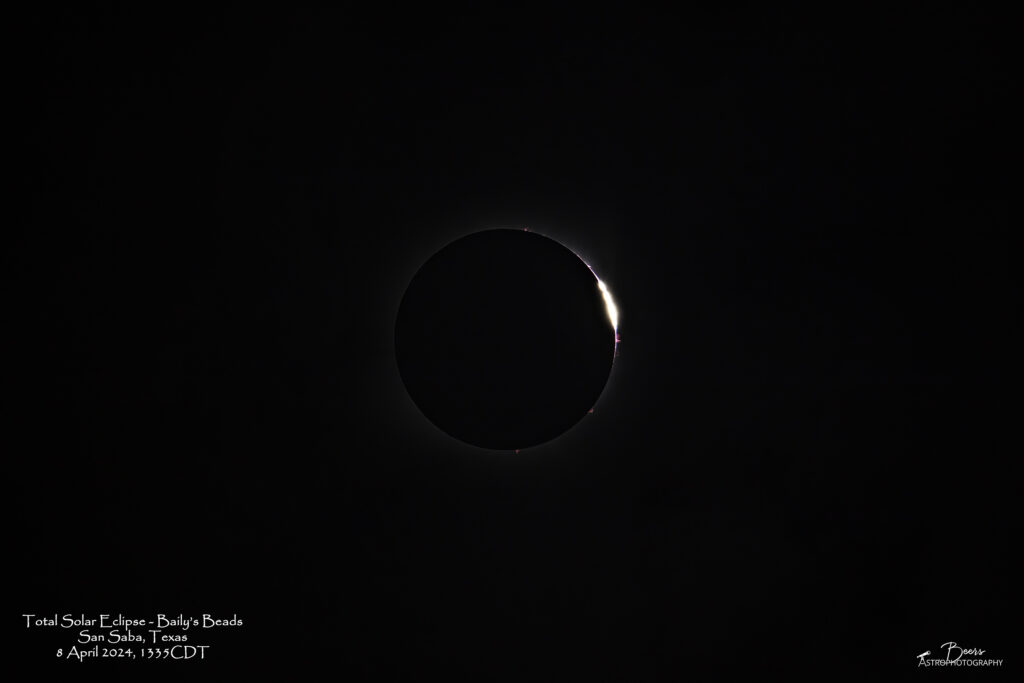

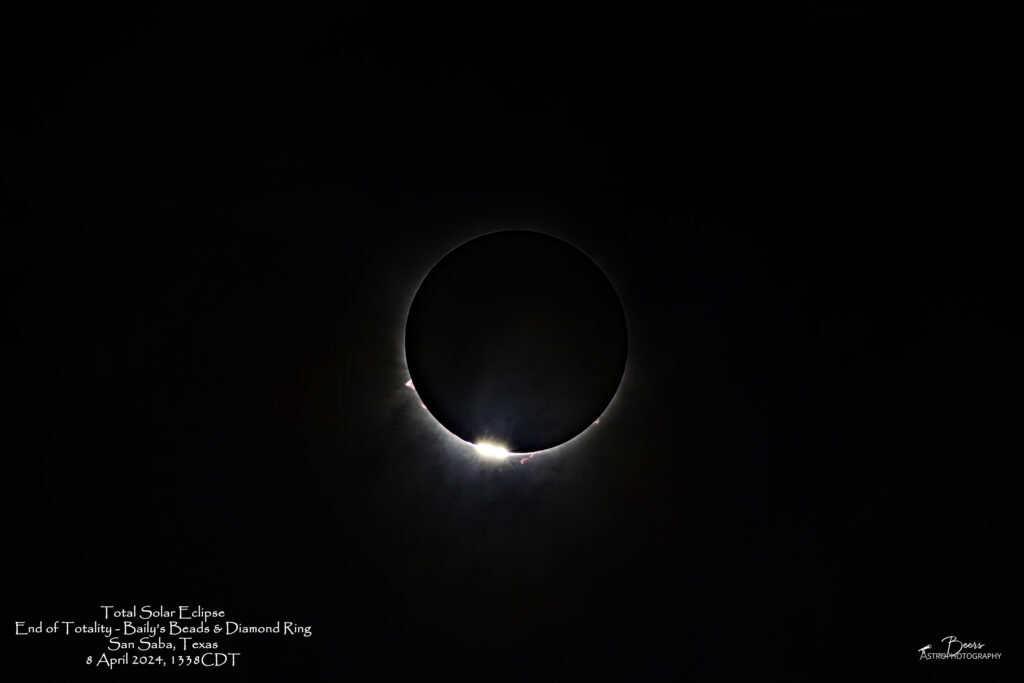
Totality phase: Diamond Ring
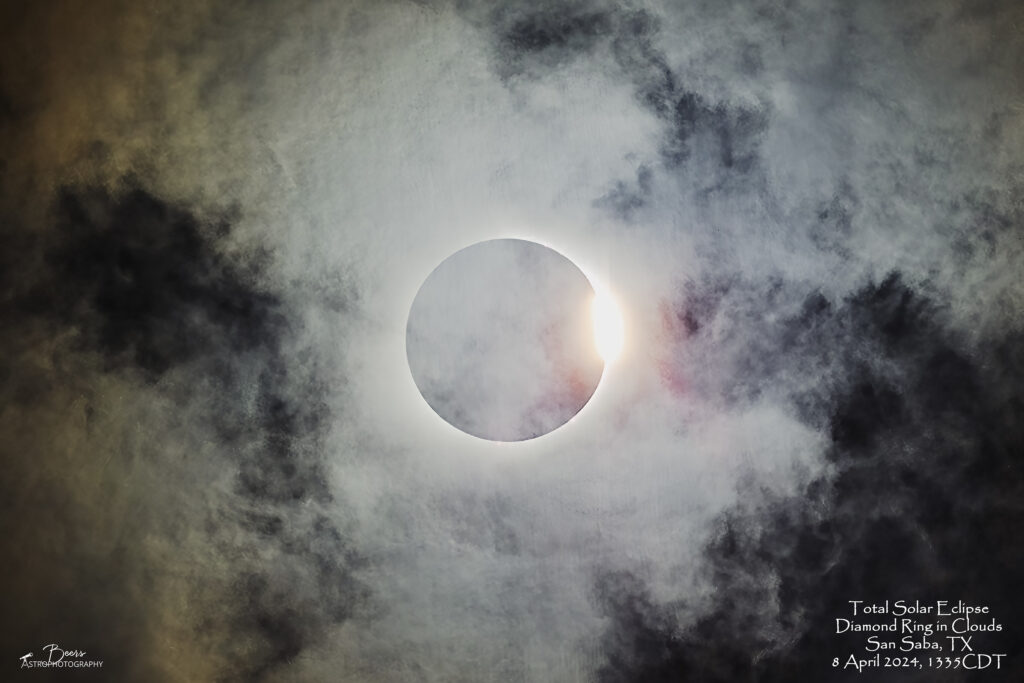


Totality phase: Chromosphere and Prominences
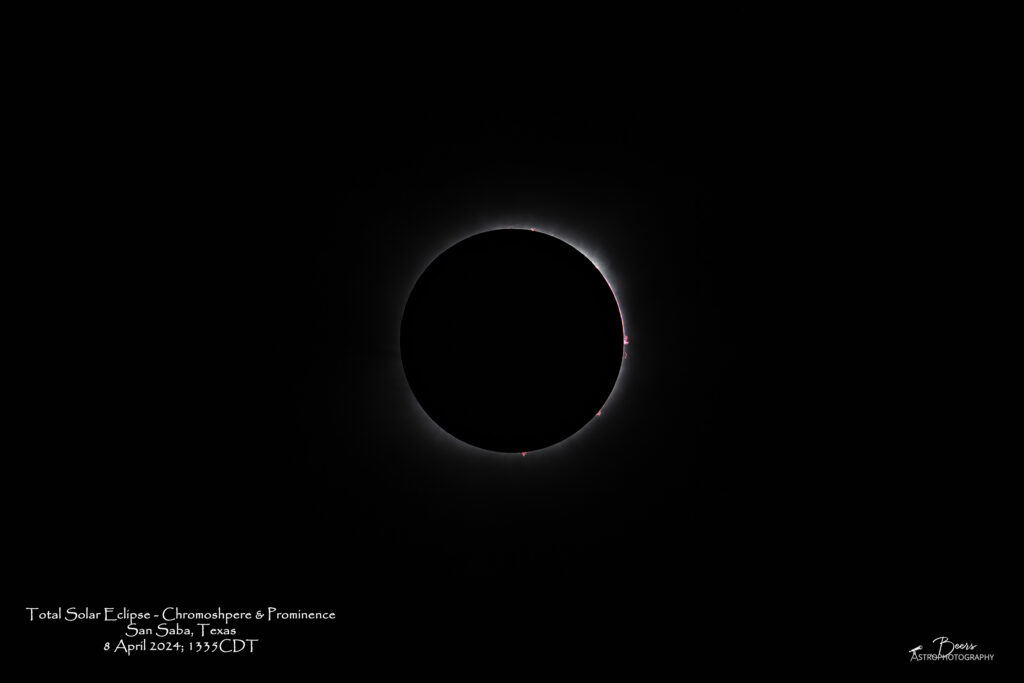
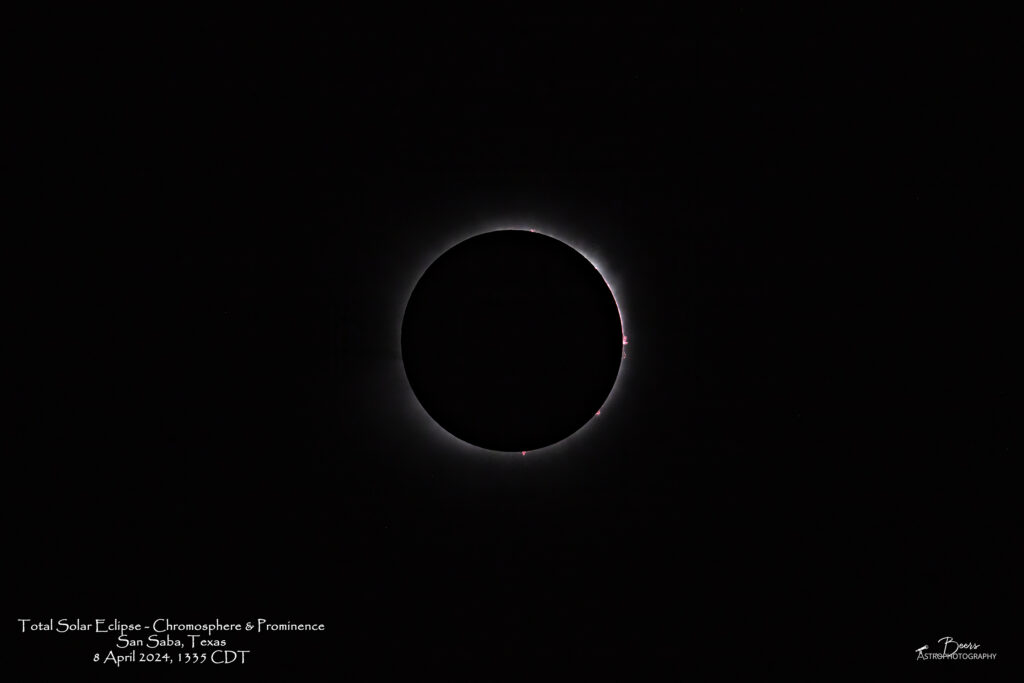
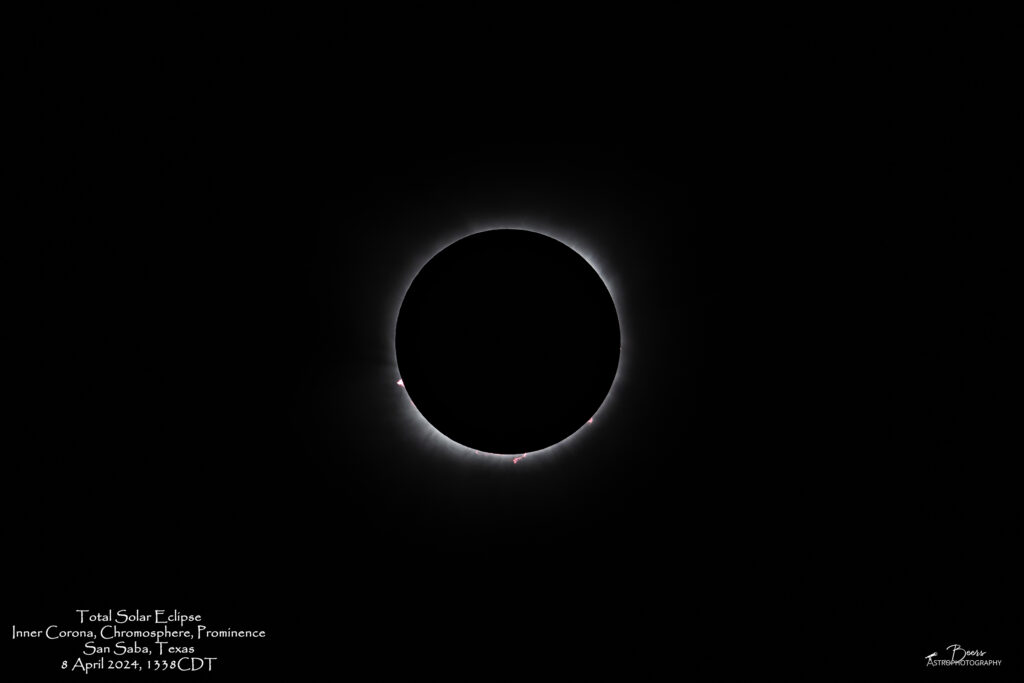
Totality phase: Corona
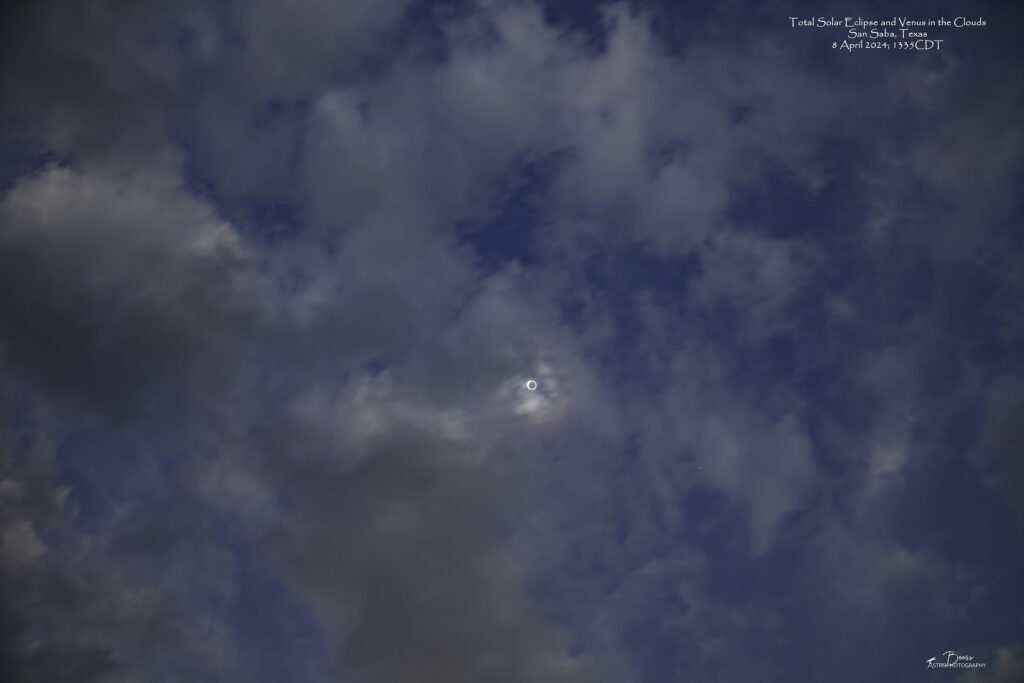

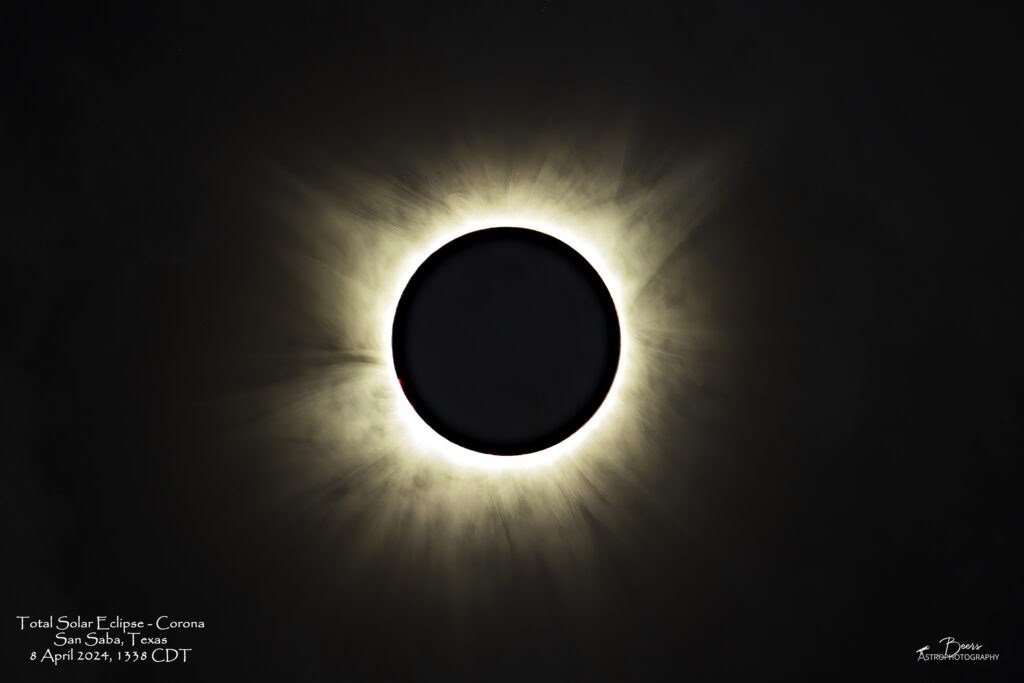
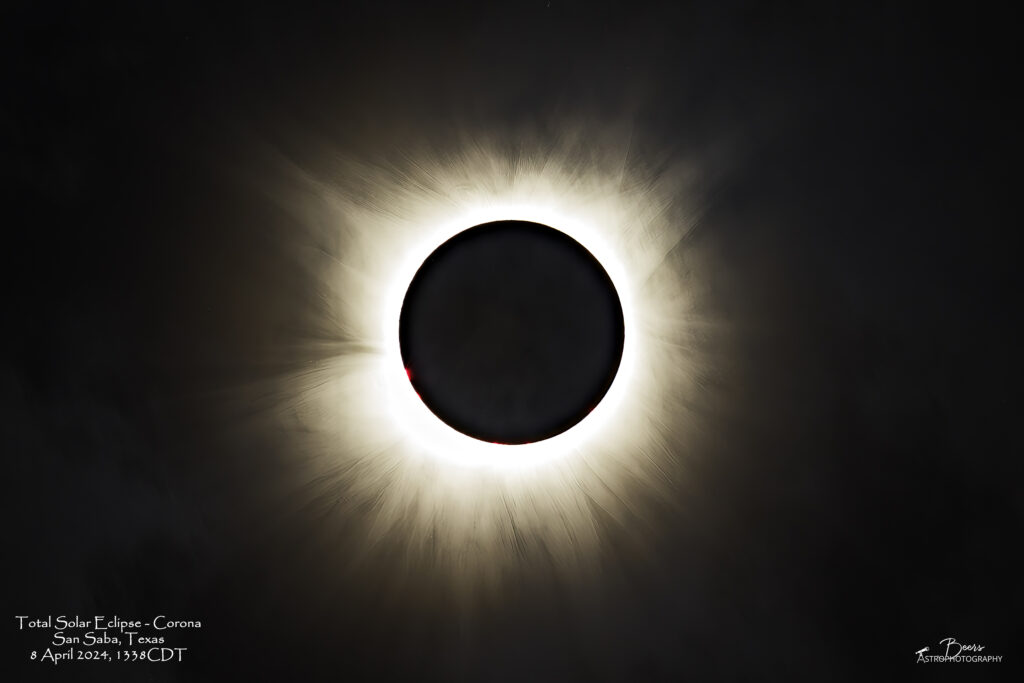
Post Third Contact: Partial Phase
